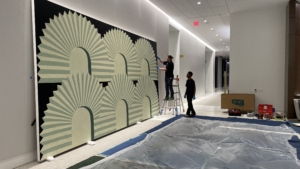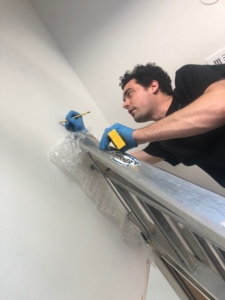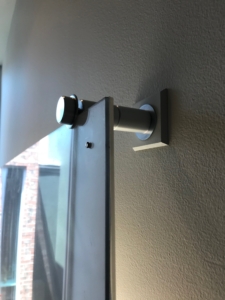You have purchased a new piece of art, now what?
You have traveled to the various art galleries, studios, and art festivals looking for just the right piece and have finally found the right one to add to your collection, or perhaps this is your first time to purchase artwork, you may ask the question of “Now what?” Fortunately there are many people out there who are ready to help. Some questions to consider are: How large is the piece? Do you need help transporting it to its new home? Is it wrapped to safely transport it? Where will it go in the new place? Will it need special hardware to install? All these questions will need to be answered to install your artwork. The questions fortunately often have simple answers. Let us look at each of these questions and evaluate what other items can be addressed.
When asking a seemingly simple question like “How large is your artwork?” there may be more than the simple answer of small, medium or large. The use of the words small, medium, and large can be awfully subjective. Consider when you order a drink at the drive through, are all large drinks the same size? What may seem to be large, may not be in comparison to other even larger works. So when speaking about the size of the work it is best to use actual measurements whenever possible.

These questions of size are as relevant to 3D works like sculptures and reliefs as they are to 2D works like paintings and photographs. The larger the work, the heavier it can be and that can create additional issues to consider. Some works are light such as a framed stretched canvas painting, but others can be exceptionally heavy such as works painted on wood panels or masonite. If it has large glazing (the protective layer over the artworks) such as glass or plexiglass is also added to the weight of a piece. All of these factors come together in figuring out how many people and what size vehicle to best safely move a piece of artwork and minimize the risks.
Now that you know how large it is, comes the question of transporting your art. Will it fit into your own car, or do you need a larger vehicle? Do you have several pieces and don’t want to make several trips? This is where an art handling company can really help. Outfitted with customized vehicles from sprinter vans to large moving trucks the handlers can quickly and easily help resolve this issue. The good art shippers will have an air conditioned box on the trucks to help maintain the integrity of the work on very hot days. Not all of the shipping trucks do, so this may be a question to ask when looking for an art shipper. The vehicles will also be able to “strap down” works with pressure or ratchet straps to the wall, securing the works while in transit. Depending on the vehicle, they will also come equipped with a lift gate for the safe loading and unloading of the work. This can be very important if the piece is particularly heavy or large.
At the beginning I mentioned wrapping the piece for shipping, what this means is that in an effort to keep the piece of work as protected as possible you will want to have it wrapped in some protective layers of materials. This is often called “soft packing” an artwork. Usually this involved the use of Dartek, an archival plastic material, Glassine, an archival paper material, or Tyvek a highly durable plastic sheet material (note that not all Tyvek is the same, and what is used by art handlers is also of a special archival quality), and usually some bubble wrap for additional cushion, either as caps on the ends or the whole piece depending on the size. Depending on how far the piece is going, such as within the same city or to a neighboring city, this may be sufficient for transportation. Otherwise, it will require additional packing such as in a masterpack, slipcase, slatted crate or full crate more typically used for long trips or if it needs to change hands in shipping. This level of packing can be determined by the gallery or the art handler as needed. Often, it is thought that a work needs to be “crated” in a wood box to be shipped, but that is not always the case, it varies depending on a number of factors.

Now that you have finally gotten it safely to its new home, where will it be installed? There are some key practical points to consider when looking for the right spot. Will it be going up high? Let us consider 2D artworks first. Some large pieces only seem to work on large surfaces and quite often that means the large open wall space of a high ceiling home. Sometimes this can be done with ladders, but it may require an equipment rental, such as scaffolding or a lift system. Will it be in a stairwell where there are working space constraints? If it is a heavy piece the wall may need to be backed with plywood to manage the heavy weight. If the walls are made of a material that is not drywall, like plaster, stone, or tile, it may require drilling to mount the hanging hardware. This will require additional time in the installation process.

The last point to think about with 2D works is the hardware needed to install the work. All good art installers will have an assortment of common hardware used to install 2D works including: hooks, hangers, nails, screws, D-rings, and wire. Some may choose to have a piece suspended on a wall from up high, this requires different hardware that is not standard, but also not uncommon. Other works might require unusual installation hardware such as stand-off pieces. Usually included with the artwork, stand-offs vary in sizes and are specific to each use. Some pieces, particularly if they are large and if they are heavy, may require a “French cleat” or a Z-bar to install on the wall. Designed as an interlocking system between two pieces to fit onto each other, this system is often the best solution for hanging very large pieces.
So then, what if you have a sculpture or some other 3D artwork? Questions for this may start with, will it be installed inside or outside? Will it go on a base such as a pedestal or plinth? Is the path clear with no obstructions, or are there steps to go up? Will it need to be secured in place once there? If it is outside, some may consider the option of setting it on a grassy spot, but the soil can erode and leave it uneven and unstable. The best choice is to always have a solid foundation for any outside sculpture. If the piece is made of marble, bronze or some other heavy material special equipment may be needed for the moving of the works into place, this will also take additional time for setting up the different aspects of installing the sculpture. In these instances a site visit may be required before the installation. Additionally, like some 2D works, some sculpture installations may require special hardware.
As you can see, there is a lot of time, effort and experience that can go into the installation of artwork. As an investment of art can be a great choice, and it should be handled as the unique, one-of-a-kind, special addition to your home. Not all cases of acquiring new artwork will require such extensive measures from the gallery to the wall, but some might and it is worth knowing the difference of when to handle it yourself and when to call in the pros.

